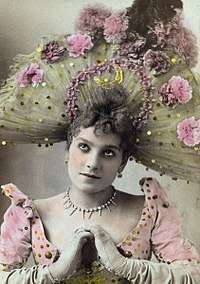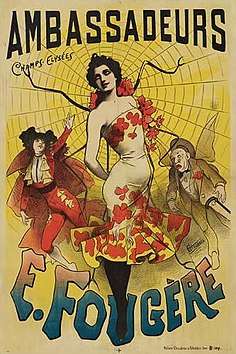Eugénie Fougère
Eugénie Fougère (Marseille, April 12, 1870 – unknown) was a French vaudeville and music hall singer. She was often called a soubrette − a flirtatious or frivolous woman − known for her eye-catching outfits, frisky movements, suggestive demeanor, and for her rendition of the popular "cakewalk dance," which in her own style included "negro" rhythms and paces.[2] She should not be confounded with the frequenter of the French demi-monde also named Eugénie Fougère although the two knew each other, mixed in the same circles and even lived in the same street in Paris for a while.[3][4][5]
Eugénie Fougère | |
|---|---|
 Eugénie Fougère in 1893 (Picture by Napoleon Sarony) | |
| Born | Marseille, April 12, 1870[1] |
| Died | Unknown, but after 1934 |
| Nationality | French |
| Occupation | Vaudeville performer |
Career

Fougère's first appearance was at the age of 12 in Avignon.[6] At the age of 15 she started her career at the Café des Ambassadeurs in Paris, where she would live the rest of her life.[5][6] Fougère became a popular and excentric singer (gommeuse[7]) and dancer that performed in famous theatres, such as the Folies Bergère and L'Olympia.[3][8]
Her first successes were as a chanteuse épileptique (epileptic singer), a genre that "created a style of sexual lewdness combined with clowning, corporeal contortions, and grimaces: the creation of a female grotesque."[9] Epileptic singers, like Polaire and Fougère, were one of the biggest attractions in Parisian night-life for the last quarter of the 19th century, due to the commercial attraction of obscenity and sexual provocation.[9]
Cake walk
Just like Polaire and Mistinguett, she became known for her "racially ambiguous" dancing techniques that she applied to ragtime and the popular "cake walk" dance of the time,[2] which became a rage at the end of 1902.[10] She is said to have introduced the dance in Paris in 1900 in the Théâtre Marigny after she returned from a tour in the United States,[11] where she had been filmed in 1899 in the rag-time cake-walk "Hello, Ma Baby," with which she made a sensation at the New York Theatre. The ambiguous "cake walk" became very popular quickly and Fougère appeared on the 18 October 1903 cover of Paris qui Chante dancing to the song Oh ! ce cake-walk. The lyrics interconnected African and American dance, monkeys and epilepsy.[12] A popular theorist of "negro dance," Andre Levinson, complied that it is impossible for Europeans to recreate the moves seen by African dance, and that is why the public is amazed by it.[13]
The "frenzied divette" was, in the art of music hall, a precursor, introducing songs and dances of all countries, long before that became fashionable in the café-concert circuit, while wearing the most unlikely toilets, bedecked with paradoxical colours.[5][6] While describing a revue at La Cigale near Place Pigalle in Paris in 1920, where she appeared in the costume of an American negro, Rae Beth Gordon, a Professor in French literature, notes that "at least in this original fantasy, she told the journalist, 'I felt my old self again.' The incorporation of blackness by this white singer suggests that the motivations for adopting a black persona and the effects of such a masquerade went beyond the purposes of simple exploitation. Fougère felt more at home in a black body — or, at least, in a body ruled by black rhythms and movements — than she did in a white body deprived of the opportunity to express itself with no holding back."[14]
In the United States
The 'audacious' Fougère made her debut in the United States on September 7, 1891, at Broadway's Koster and Bial's Music Hall in New York, where she quickly became "the craze of the hour".[15][16][17] According to a review, "New York never saw anything to equal the performance of Fougere. Imagine an Apache in a setting of petite Parisian femininity."[15] Her influence over the audience was due "to the sparkle, wildness and vim of her performance".[15] Not everyone was impressed; theatre critic Leander Richardson called her "the most daring interpreter of indecency" and wrote that she dealt "in just plain sexual dirt, and looks the part".[18]
Fougère toured the States for many years, but her performance was often too 'strong' for the audience. She was hissed of the stage in Kansas City, for example. "The people think I'm — ah — what you say? Naught-ee?," she commented. "Ah. monsieur, they don't understand. They will learn. Ah, these Americans, they are just a little slow, but they all like 'the great Fougere' when they know her. But, o-o-ooh ! I'm all breathless, c'est terrible!"[19]
Her performances often shocked the puritan North Americans and revealed their hypocrisy. In October 1907, while she was performing at the Gaiety Theater[20] in Washington, she was brought to the police station where she had to pay a "cash security of USD 50 to insure her good behavior." Despite the fact that the police sergeant enjoyed her show on the front row, in particular her "specialty", he nevertheless said he was shocked and dragged her off to the police station.[21]
She performed all over the world, notably in Spain, Cuba, Mexico,[22] Germany and Italy.[6] While performing at the Salone Margherita a café-chantant in Naples (Italy) in 1902, she contacted Camorra boss Enrico Alfano to ask for help in returning some of her missing jewelry. Within a few days, Alfano tracked down the thieves and restored the jewelry. The case hit the newspapers and Alfano was arrested for complicity with the thieves, but was absolved.[23]
Shoplifting
In May 1906, Fougère and her husband, the actor Albert Girault (also spelled Girod), were convicted of shoplifting a night dress, lingerie, and other items one particular night after leaving a London-based textile company, Lewis & Alleby's.[24][25] She was performing at the Oxford Music Hall for a substantial salary and claimed she had forgotten to pay. The charges were dismissed on appeal.[26] She had a reputation for spending money fast.[25]
In 1909, she made an appearance in Montreal that shocked and scandalized the audience because of the routines in her performance and the "excessive display of lingerie".[27] A Montreal Gazette article the next day mentioned that, "Mademoiselle Eugenie Fougère, the French music hall actress, who was announced to appear at Bennett's as headliner during this week, made her first and last appearance at that theatre yesterday afternoon. Although such acts as she presented might be quite acceptable in the music halls of London and Paris, they certainly should have no place in the bill of any Montreal theatre." The manager of the theatre told Eugénie that she would not be allowed to appear again.[27]
Later life
According to Gordon she shortly returned to stage in 1920 "after a long hiatus," in the Ambassadeurs alongside the French dancer and actress Polaire.[14] That year, she is said to have introduced the Cuban rumba in France with the Cuban dancer Enrique Madrid at a World Championship in Mondern Dancing, organised by Comœdia, after a long stay in Cuba.[28][29] However, in an interview with Maurice Hamel (fr) for Comœdia in 1925 she complained she had no engagements anymore and about her lost fortune (jewelry worth FF 275,000 had been stolen from her).[6]
In a retrospective in 1934, Hamel recalled her small apartment in Paris in which the walls were covered with photographs, as if she had created her own museum, in which she reminisced about her rich career. She said she had had many difficulties to correct the false notice of her death in 1903 when she was confused with her namesake.[5][6] In 1937 she played a vieille coquette in the film Pearls of the Crown (French: Les Perles de la couronne) by Sacha Guitry.
Legacy
Gordon notes that the popularity of performers like Eugénie Fougère "was comparable to that of Elvis Presley a little more than half a century later."[30] She was the inspiration for several noted dancers, actresses, and singers of the time to incorporate the "negro" and African style of dancing she used in their routines and shows. She was also one of the pioneer burlesque music hall and theatre performers.[14] Fougère was included in a mural in rooftop bar of the Knickerbocker Hotel at Times Square in New York City, when it re-opened in 2015, to commemorate the time the hotel was the hottest spot in town, in the early 1900s.[31][32] In 1907 she was kicked out of the hotel because she shared a room with her male manager - although they were married, as became clear later.[31]
She was mentioned by name in the classic Frank Wedekind tragedy Erdgeist (Earth Spirit). During act I, the character Lulu stated in response to a question about her dancing, "I learned in Paris. I took lessons from Eugenie Fougère. She let me copy her costumes too."[33] The Italian actress and singer Anna Fougez adopted her stage name as a tribute to Fougère.[34]
References
- Notes
- Eugenie Fougere of Paris, The Buffalo Courier, December 23, 1894
- Gordon, Dances With Darwin, p. 236
- (in French) Un assassinat à Aix-les-Bains, Le Figaro, September 21, 1903
- Bossy, Les Grandes Affaires Criminelles de Savoie, pp. 81-104
- (in French) Les survivants du Caf’Conc’, by Maurice Hamel, Lectures pour tous, August 1934
- (in French) La 'Gommeuse excentrique' Eugenie Fougere, Comœdia, September 12, 1925
- Gordon, Why the French Love Jerry Lewis, p. 76
- (in French) Les Chansons illustrees
- Gordon, Rae Beth (2004). Fashion and the White Savage in the Parisian Music Hall, Fashion Theory, 8:3, pp. 267-299
- Moore Whiting, Satie the Bohemian, p. 299
- See: Le Journal, 20 January 1903 and Le Figaro, 13 February 1903
- Gordon, Dances With Darwin, p. 177
- Levinson, Andre. Theatre: Essays on the Arts of the Theatre. pp. 235–245.
- Gordon, Dances With Darwin, p. 239
- Theatre Dancing; Now it is the Lofty Jump That New York Raves Over The Salt Lake Herald, November 1, 1891
- The New York Clipper Annual for 1892
- Koster & Bial’s New Season, The New York Times , September 11, 1894
- Naughty Fougere Is Coming Back; Singer of Doubtful Ditties Engaged as a Roof Garden Attraction, The Morning Telegraph, 24 August 1899
- Hissed Her of the Stage; Mme. Fougere’s Too French Gestures Displeased Her Audience, The Pandex of The Press, January 1908
- Lost Washington: The Gayety Theater, Greater Washington, January 26, 2011
- Fougere "pinched", Variety, October 5, 1907
- Company for Mexico, Variety, September 16, 1911
- Paliotti. Storia della Camorra. pp. 191–98.
- "Sad Downfall of Famous Artiste". Gazette Times. May 27, 1906.
- The Fall of Fougere; Parisian Stage Favorite In A Jail In London. The Syracuse Herald, June 3, 1906
- Fougere Goes Free, The New York Times, July 22, 1906
- "Act Too Naghty". Montreal Gazette. December 14, 1909.
- (in French) Championnat du Monde de Danses Modernes, Comœdia, 19 June 1920
- (in French) La vraie «rumba», Comoedia, 22 September 1932
- Gordon, Dances With Darwin, p. 12
- If This Wall Could Talk, New York Daily News, April 26, 2015,
- Our History The Knickerbocker Hotel website (accessed 22 September 2017)
- Wedekind, Frank (1914). Erdgeist. A. and C. Boni. pp. 24.
eugenie.
- (in Italian) "Pappacena, Maria Annina Laganà, in arte Anna Fougez" by Doriana Legge in Enciclopedia Italiana: Dizionario biografico, Treccani, 2014.
- Bibliography
- (in French) Bossy, Anne-Marie (2007). Les Grandes Affaires Criminelles de Savoie, Romagnat: Editions de Borée, ISBN 978-2-84494-503-7
- Gordon, Rae Beth (2001). Why the French Love Jerry Lewis: From Cabaret to Early Cinema, Stanford (CA): Stanford University Press, ISBN 978-0-8047-3894-1
- Gordon, Rae Beth (2009). Dances With Darwin, 1875-1910: Vernacular Modernity in France, Farnham: Ashgate Publishing, ISBN 978-0-7546-5243-4
- Moore Whiting, Steven (1999). Satie the Bohemian: From Cabaret to Concert Hall, Oxford: Oxford University Press, ISBN 0-19-816458-0
- (in Italian) Paliotti, Vittorio (2006). Storia della Camorra, Rome: Newton Compton editore, ISBN 88-541-0713-1